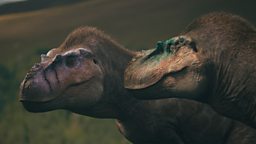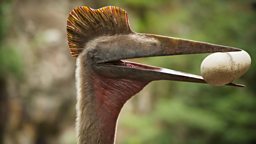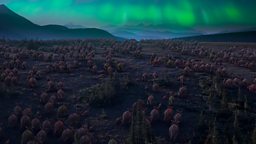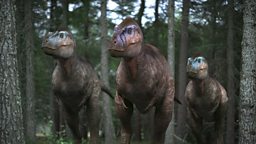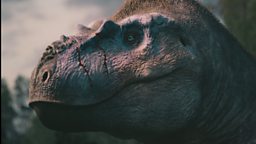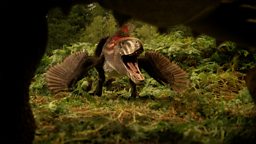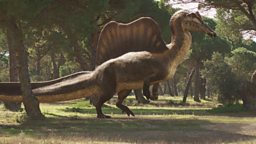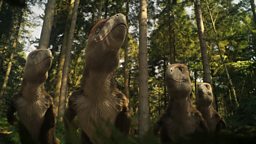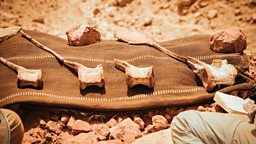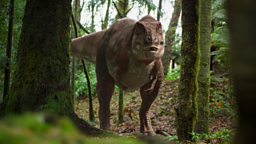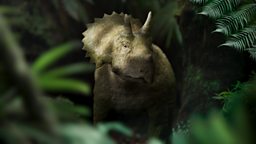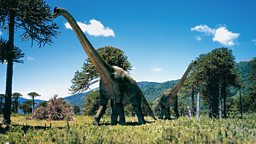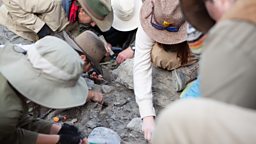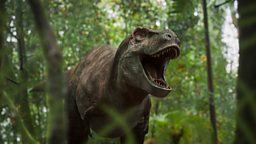Dino guide: Creating Lusotitan
by Jay Balamurugan, series assistant producer
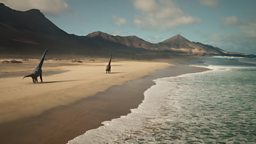
All is fair in love and war – even in the Jurassic. On the ancient Iberian Meseta, the colossal Lusotitan, Old Grande, is in search of a mate. An effort that is much easier said than done. Our hero not only has to fend off opportunistic apex predators and a fierce rival but must also impress his love interest – in the most extravagant of ways.
when a dinosaur happens to do something interesting at just the right moment, a geological snapshot of that event can be captured.
Dinosaur behaviour is one of the hardest things for scientists to figure out due to just how limited the fossil evidence can be. Dinosaurs surely exhibited interesting and diverse behaviours, like modern animals do – but that doesn’t really show up in the fossil record, not without a tremendous amount of luck. But when the conditions are just right, and when a dinosaur happens to do something interesting at just the right moment, a geological snapshot of that event can be captured. Footprints, bite marks, skin impressions, pigment cells, braincases, and injuries can all tell palaeontologists a great deal about what a particular dinosaur got up to in its lifetime. In the rarest and most sought-after of cases, some dinosaurs are fossilized while doing something spectacular – some of the most famous examples include a Protoceratops (a horned dinosaur) and Velociraptor buried by a collapsing dune while locked in combat or an Oviraptor engulfed by a sandstorm while incubating its nest of eggs.
Island of Giants was a great opportunity for us to show off just how complex and dynamic dinosaurs could be. Classically, the long-necked sauropod dinosaurs have been depicted in popular culture as gentle giants doing little beyond nibbling leaves. However, thanks to recent discoveries in Portugal, we had the opportunity to buck that trend. The fact that multiple Lusotitan, a species that until now had only ever been found alone, were buried so close together, opened myriad possibilities.
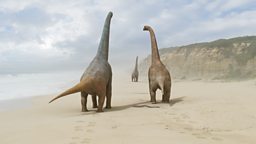
The first, and most dramatic possibility was, as outlined by our on-screen palaeontologist Francisco Ortega, “If these two big strong animals live in the same ecosystem at the same time there is going to be some kind of competition.” Large herbivores today are often fiercely adversarial when competing over resources or mates. Elephants, rhinos, giraffes, and even giant tortoises will all engage in dramatic, sometimes incredibly violent, combat, and the loser doesn’t always get away with just a bruised ego. The fights a 40-tonne Lusotitan must have engaged in would have been on an entirely different order of magnitude – and must have been truly epic to see. But why would they have fought? Perhaps for ‘love’! Studies have shown that in the animal kingdom today, more often than not, access to mates is the primary driver of confrontation between rivals. From deer antler-locking and elephant seals body-slamming, to giraffes neck-smashing and kangaroo kick-boxing, some of the most impressive fights today are driven by that age old ambition – to prove themselves the right choice of mate.
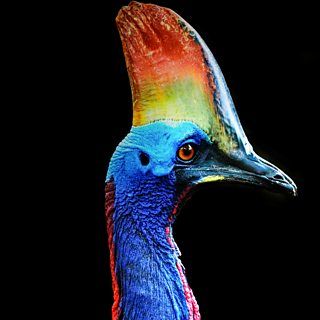
But for Old Grande, fighting off a rival is only the start. In the natural world, animals will go to extraordinary lengths to impress a potential mate. Scientists think that these elaborate methods convey how healthy and strong an animal is, and therefore, how healthy and strong their offspring will be. With birds and reptiles today exhibiting some of the most jaw-dropping displays in the animal kingdom, Old Grande had a lot to live up to.
The aging giant sports a body mottled in hues of tans, reds, and most strikingly, blues. Scientists now think that dinosaurs had excellent colour vision, much better than that of our modern large mammals. We deliberated on just how vibrant we could make Old Grande and looked to large birds and reptiles for inspiration. One thing we learned early on was that blue was a surprisingly common colour in these groups, and often exceptionally stunning, even among large animals. Cassowaries, the second heaviest birds on Earth, show deep, rich blues, all along their long necks, accented with reds and yellows. For an adult Lusotitan, there is no real reason not to be flashy – after all, when you’re the size of a humpback whale, camouflage isn’t exactly on the table. Why not use all that real-estate to make a statement?
Now he has her attention, Old Grande needs to prove he’s a compatible mate – with a synchronised dance. Dancing dinosaurs might initially seem an outlandish idea, but it has merit in the form of some interesting fossils. There are fossil sites showing large, striated gouges in the rock, made when a dinosaur scraped its feet back and forth as part of a courtship ritual, just like modern birds do. Choreographing a 40-tonne Lusotitan therefore relied greatly on their living cousins. Swaying, stomping, and bobbing are all important to the routine, and a single step out of sync could ruin everything. But when all goes wrong, Old Grande still has one final trick up his 3-metre-long sleeve.
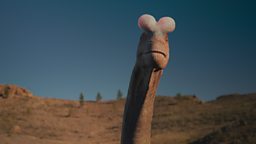
Watching the team react to Old Grande’s inflatable sacs was a highlight of my time on the production. From bursting out in laughter to gasping in surprise, his grand finale made a huge impact.
Old Grande has proven himself to be the most eligible bachelor on the island
Many animals today, such as frigate birds and hooded seals, use inflatable sacs for display, but what leads us to think dinosaurs may have done the same? The answer lies in their bones. For the longest time, scientists have wondered what on Earth was going on with that giant chamber in the skulls of certain sauropod dinosaurs. In the earlier days of modern palaeontology, some scientists even thought it may have been the anchoring point for an elephant-like trunk! More recent science has pointed towards these animals housing inflatable sacs in their nasal regions. Taking in an especially big breath, shutting their nostrils, and exhaling, would send air into this chamber and inflate two balloons of skin, making for a truly unforgettable show.
After all that, I think it’s safe to say that Old Grande has proven himself to be the most eligible bachelor on the island.
